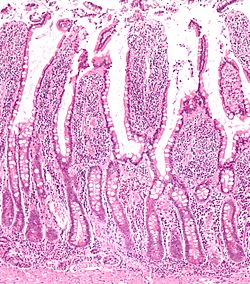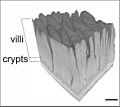Villi facts for kids
Quick facts for kids Intestinal villus |
|
|---|---|
 |
|
| Micrograph of the small intestine mucosa showing villi – top half of image. H&E stain | |
 |
|
| Section of duodenum of cat. X 60. | |
| Latin | small intestinales |
| System | Digestive system |
Villi are super tiny, finger-like parts found in your small intestine. Think of them like tiny folds or bumps on the inside wall of your gut. Each villus is very small, about 0.5 to 1.6 millimeters long in humans. That's less than the size of a grain of rice!
These amazing little structures have a huge job. They help your body take in, or absorb, all the good stuff (like nutrients) from the food you eat. Without them, your body wouldn't get the energy and building blocks it needs to grow and stay healthy.
Contents
How Villi Help You Absorb Nutrients
The main job of the villi is to grab nutrients from your digested food. Imagine your small intestine as a long tube. As food moves through it, the villi are there to catch the nutrients.
- Rich Blood Supply: Each villus has lots of tiny blood vessels inside. Once nutrients are absorbed by the villi, they quickly move into these blood vessels.
- Travel Through Your Body: From the blood vessels, the nutrients travel through your bloodstream. They then go all over your body to power your cells and help you do everything from thinking to running.
The Power of Micro-Villi
To make sure you absorb as many nutrients as possible, each villus has even tinier parts called micro-villi. These are like even smaller fingers on top of the villi!
- Bigger Surface Area: The micro-villi make the inside surface of your small intestine much, much larger. Think of it like unfolding a crumpled piece of paper. The more surface area there is, the more space there is for nutrients to be absorbed quickly and efficiently. It's like having a super-sized sponge to soak up all the good stuff!
Why Healthy Villi Are So Important
Your villi are vital for your health. If they get damaged or don't work right, your body can't absorb the nutrients it needs. This can lead to feeling tired, not growing properly, and other health problems. Keeping your digestive system healthy helps your villi do their important work!
Images for kids
-
Transverse section of a villus, from the human intestine. X 350.
a. Basement membrane, here somewhat shrunken away from the epithelium.
b. Lacteal.
c. Columnar epithelium.
d. Its striated border.
e. Goblet cells.
f. Leucocytes in epithelium.
f’. Leucocytes below epbithelium.
g. Blood vessels.
h. Muscle cells cut across.






